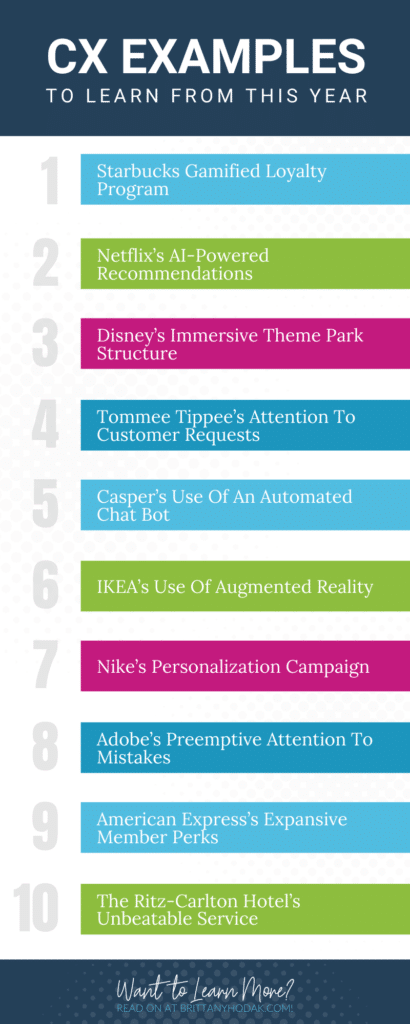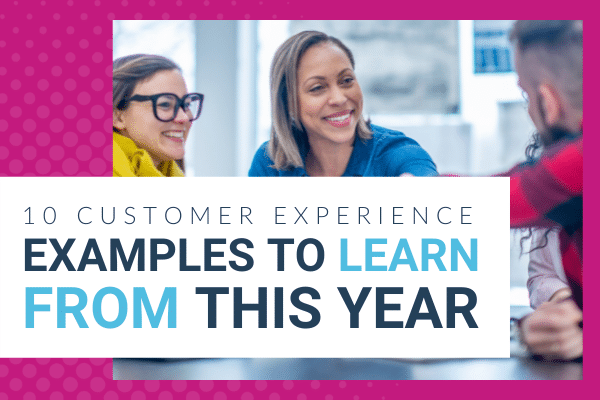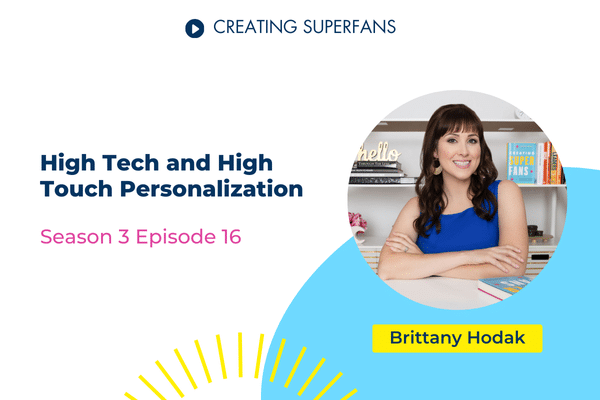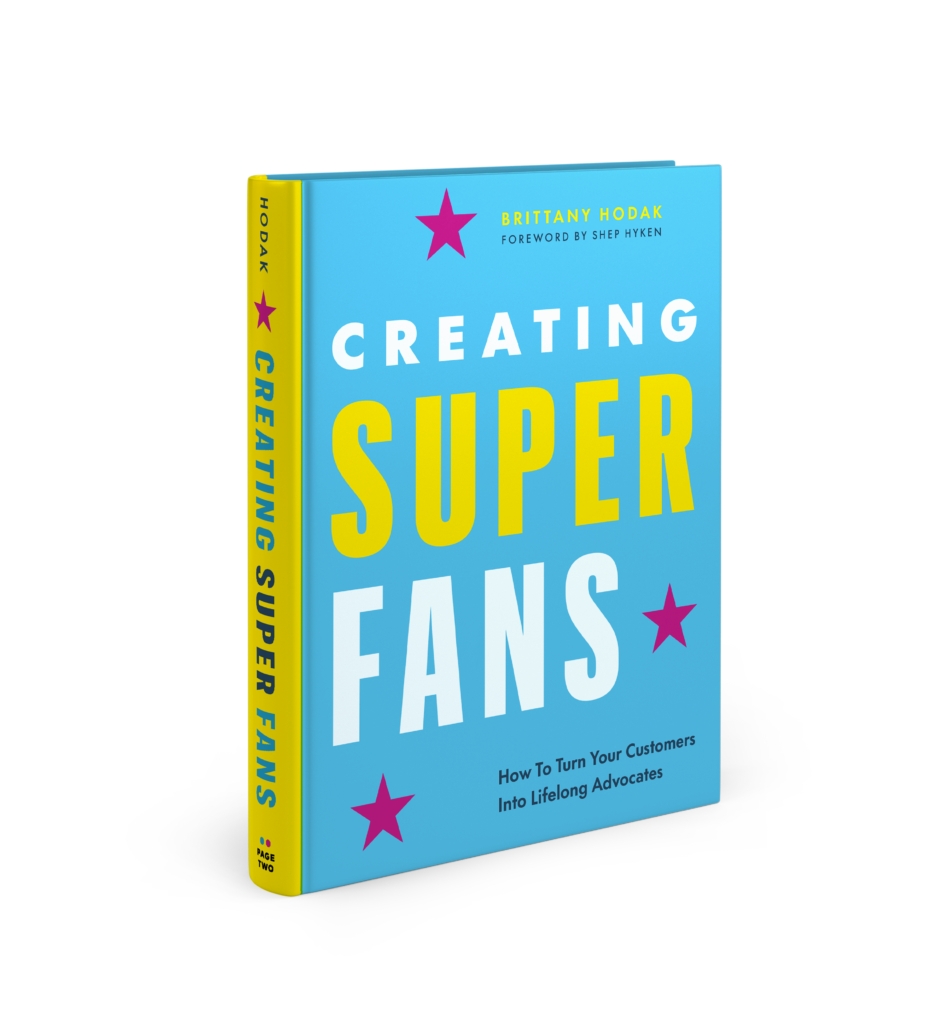Customer experience is more than a buzzword. It’s the next big battleground for today’s businesses. If you want to stand out from the competition, you need to learn from the top customer experience examples. What makes a strong customer experience (CX) is constantly evolving with consumer expectations. The only thing that’s certain is that you can never get too comfortable.
With more companies competing on customer experience than ever before, how do you continue to create real-world superfans? A superfan is someone who’s actively passionate about your brand. These are your most loyal customers, and they’re worth their weight in gold. While the probability of selling to a new customer is low, the probability of selling to an existing, engaged customer is up to 70%.
This means it’s time to invest in your CX if you want to achieve the best results. Luckily, you don’t have to completely start from scratch. While creativity is always a good thing, you can learn from the top customer experience examples of the year. In this day and age, it’s never been easier to see customer experience in action for yourself.
These 10 customer experience examples below go beyond the basics to transform passive users into diehard superfans. Though it took time, energy, and strategy, it paid off in a big way. What can you learn from the 10 leading examples on this list?
- Starbucks Gamified Loyalty Program
- Netflix’s AI-Powered Recommendations
- Disney’s Immersive Theme Park Structure
- Tommee Tippee’s Attention To Customer Requests
- Casper’s Use Of An Automated Chat Bot
- IKEA’s Use Of Augmented Reality
- Nike’s Personalization Campaign
- Adobe’s Preemptive Attention To Mistakes
- American Express’s Expansive Member Perks
- The Ritz-Carlton Hotel’s Unbeatable Service
- Unlock the Power of Customer Experience
Starbucks Gamified Loyalty Program
First, one of the best examples of a customer experience strategy that translates to real customer loyalty is from Starbucks. The coffee giant used its fully digital loyalty program to build coffee culture into Americans’ everyday routines. Known as Starbucks Rewards, this loyalty program creates a personalized mobile experience to empower customers to order and pay using their smartphones.
By interacting with the app and purchasing drinks regularly, customers earn free perks and rewards. These offers do more than generate excitement around frappuccinos. In fact, the Starbucks Rewards Program increased the average customer order by 21%. This translates to huge growth year-over-year.
Starbucks even goes so far as to gamify its loyalty program. Known as Starbucks Starland, this reward game lets customers explore the history and future of coffee for a chance to win prizes, raffle tickets, and more. These aren’t just fun games—they’re also a new way to encourage customers to engage with the Starbucks brand.
Netflix’s AI-Powered Recommendations
Next, we can all relate to the frustration of scrolling endlessly without finding anything to watch. In the day of digital streaming, viewers are bombarded with decision fatigue. Netflix invested in their customer experience to combat this problem, creating their AI-powered recommendations.
This didn’t happen overnight. Netflix spent years tweaking its algorithms to highlight the best content for its 180 million subscribers. Their goal is to increase viewership and decrease member churn. With seemingly new streaming options every day, these AI-based recommendations are expected to save Netflix up to $1 billion a year on churn.
With more options than ever before, Netflix still continues to lead the way. In fact, Netflix added 36 million subscribers in 2020 alone. Much of this is due to their strong algorithm recommendations, making the customer experience as seamless as possible.
Disney’s Immersive Theme Park Structure
Another company that’s known for its attention to detail with the customer experience is Disney World theme parks. Their immersive theme park structure fully commits to wowing fans with the overall guest experience. With a return rate of 70% for first-time Disney visitors, a Disney trip is far from once-in-a-lifetime. Rather, it’s becoming the default for family vacations across the globe.
What does Disney do right? The real “magic” is in their cast members, technology, and theming. By optimizing the mundane and encouraging cast members to go above and beyond, even small interactions have a special their own pixie dust. The magic doesn’t start when you arrive at the theme park. It actually begins as soon as you start your planning from the My Disney Experience app.
From there, you’re encouraged to interact with park reservations, learn more about your trip, and discover new excitement. This immersive structure is what sets Disney apart from similar theme parks, and it’s why so many guests return each year despite rising prices.
Tommee Tippee’s Attention To Customer Requests
Nowadays, it’s not uncommon to see a brand go viral on social media. However, this is too often for the wrong reasons. One brand that used its social media presence as a way to make a positive impact is Tommee Tippee. This sippy cup brand pays close attention to customer requests on social media, especially when those requests are so meaningful.
When the father of one autistic child looked for a replacement for a limited edition Tommee Tippee cup, he took to social media. Using the hashtag #CupsForBen, the tweet went viral, attracting thousands of retweets. In response, Tommee Tippe created a limited run of their discontinued cups for Ben and other families. Though simple, this action shows a dedication to service that isn’t often seen in everyday brands.
Casper’s Use Of An Automated Chat Bot
Another way to serve customers quickly and effectively is by using a chat bot. Casper, an up-and-coming mattress retailer, was one of the first in the space to leverage the power of artificial intelligence (AI) to create a stronger customer experience. Known as Insomnobot3000, this chat bot specifically helped prospective customers who struggled with sleeping well.
Active during the day, customers only need to chat or text Insomnobot3000 to initiate a conversation. Not only was this a way for Casper to learn from customer data and needs, but it also created a personalized experience. As most successful brands know, it’s important to feel heard and understood—even if it’s through a targeted chatbot.
There are many different types of customer feedback brands can use to better serve their audience. According to Zendesk, feedback can be qualitative (like a written review) or quantitative (like a customer satisfaction score). By using an automated chat bat to collect feedback and first-party data, Casper gathers both qualitative and quantitative customer feedback.
IKEA’s Use Of Augmented Reality
As you can see from the Casper example, innovation and technology go a long way in terms of customer experience. Another brand that didn’t shy away from new tools is IKEA. By launching an augmented reality (AR) application, users can test IKEA furniture and decor in their own homes. Known as IKEA Place, this free app includes realistically rendered 3D products with 98% accuracy.
Purchasing furniture, especially online, can be difficult. Not only is this a big purchase, but it’s something you want to keep for a long time. IKEA knows this, and they used AR technology to simplify this decision process for on-the-fence customers. When customers can visualize a product within their space, they’re more likely to go ahead with their purchase. This is an idea many other furniture brands are leveraging for themselves, like Amazon. However, IKEA is only likely to take it further.
Nike’s Personalization Campaign
Similarly, customers value personalized experiences more than ever before. In fact, a reported 71% of customers feel frustrated when brand experiences don’t feel personal. As a leading athletic brand, Nike knew their customers wanted to feel connected with their sport, progress, and activity levels. Their Nike By You line allows customers the ability to completely personalize and customize their Nike shoes, getting the perfect style and fit every time.
Beyond fashion choices, Nike+ is a sensor used to track time, distance, pace, and calories burned. It’s compatible with Nike shoes, and it is also synchronized with a Nike+ tracking device (smartphone, smartwatch, and so on). This allows customers to dig deeper into their own experiences, making the most of their Nike products. Not only do they feel their athletic gear is designed for them, but they can use their products to improve their performance.
Personalization is going farther than ever before. With the rise of wearable technology, it’s never been more important for retail brands to leverage this data in new ways. In just 3 years, the number of wearable devices worldwide more than doubled. Nike’s use of Nike by You and Nike+ ensure the brand is at the forefront of this innovation.
Adobe’s Preemptive Attention To Mistakes
Just as customers want personalization, they also want to feel heard. No matter how much planning you do, things occasionally will go wrong. What’s important is how brands manage these mistakes, and how they make things right. The creative software suite Adobe is the perfect example of this.
When Adobe experienced a server outage, they posted a tweet before they even received customer complaints. Not only was this tweet lighthearted, but it got ahead of the issue. Because customers knew Adobe was already aware and on top of it, this led to greater trust down the line. Learning how to handle mistakes quickly and efficiently is key to creating a strong customer experience.
Hi all, some Adobe services are down due to the AWS outage: https://t.co/U2qtybaT8J Here's a puppy stampede to take your mind off of it. 😍 pic.twitter.com/Glv6Anavje
— Adobe Care (@AdobeCare) February 28, 2017
American Express’s Expansive Member Perks
Next, some brands excel at the customer experience by providing thoughtful perks for existing customers. While these perks not only attract new customers, they also ensure their current customers are loyal superfans. American Express goes above and beyond to meet (and exceed) customer expectations with their credit card memberships.
With access to travel flight credit, insurance, airline lounge access, 24/7 support, and global partner brands, this is a convenient way to explore the world. Customers can also access assistance across the globe, regardless of timezone. When members are traveling or using their credit card, they want the experience to be seamless.
With American Express, customers feel confident their needs will be met. This isn’t just a feeling. It’s backed by real stats. In 2020, American Express ranked top in the J.D. Power Customer Satisfaction study amongst all national credit card issuers. Customers rank expanded benefits, customer service, and digital tech tools as the reasons American Express continues to stay on top.
The Ritz-Carlton Hotel’s Unbeatable Service
Last but not least, having the best customer experience comes down to providing unbeatable service. When looking at the hospitality space, it’s impossible not to admire the Ritz-Carlton hotel. In fact, the Ritz-Carlton values the customer experience so much, it empowers employees to spend up to $2,000 to fix any guest problem.
One famous story about the Ritz-Carlton’s commitment to service is how one employee at the Sarasota, Florida location noted a guest left his laptop charger behind. Instead of waiting for the customer to contact the front desk, he took initiative. This employee sent the guest his charger by next-day air, including an extra just in case. By anticipating the customer’s need for his laptop charger, the Ritz-Carlton showed its commitment to high-level service.
The Ritz-Carlton includes these values at the heart of their company motto. Their Gold Standard for service begins with the memorable phrase, “We are ladies and gentlemen serving ladies and gentlemen.” With this in mind, employees use this framework to treat both guests and colleagues with dignity, respect, and service in mind.
Unlock the Power of Customer Experience
Ultimately, your customer experience relies on a variety of factors. From brand loyalty to customer service, it’s all about making sure your audience feels heard and understood. These customer experience examples show just how important it is to go above and beyond. With more brands competing on customer experience than ever before, this is how you stand out.
It’s not enough to provide an average experience. It’s not even enough to provide a great experience. Today, brands need to unlock the power of customer experience by exceeding customer expectations in new ways. As industries continue to grow and change, it’s never been more essential to have valued superfans.






